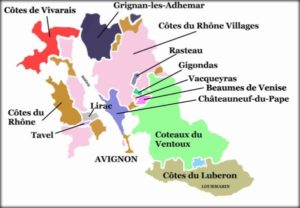
Today, most wine education takes the form of a guided tour of what we might call the appellation trail. Since appellations constitute the fundamental categories nation states use to organize and police the wine produced within their borders, familiarity with them would seem to be important to developing a comprehensive view of the wine world and making one conversant with its vocabulary. So what exactly is an appellation, anyway?
Here’s the punchy definition I like to use: An appellation is a set of instructions for making a particular wine in a particular place with a view to a achieving a particular style.
Appellations exist to reduce what would otherwise be an unmanageable torrent of wine into cognitively navigable channels. Yet, I find that many of our wine corner clientèle don’t really understand how or why a Côtes du Rhône and a Châteauneuf du Pape differ (apart from price) or what might differentiate appellation-designated wine from non-appellated alternatives: what you might call ‘freestyle’ wine.
For quite a while now, I’ve made a project of coming up with analogies that might help explain what these geographically-designated, name-protected, legislated categories are and should mean to someone struggling with the concept. What follows is the current contents of my appellation analogy cabinet. These appear in no particular order. I’ve added a few explanatory notes to each.
You can think of an appellation as . . .
A kind of deed. Look closely at the document that governs a given appellation and you will always find a section of ‘metes and bounds’ language. It’s virtually identical to what appears in deeds and mortgage documents to describe the location of the real estate in question. Appellation rules precisely describe the extent of the terrain where fruit may be grown.
An algorithm. In this view, an appellation is a just set of condition-dependent steps that once established can be executed to produce predictable results.
A meme. A cultural phenomenon that replicates itself non-genetically by an ongoing and often accelerating sequence of example and iteration.
A habit. Learned behavior performed over and over, more or less unconsciously — or at least without serious reflection as to why or how we’re doing what we are. Never creative, but a notable time and energy saver.
A dress pattern. Want to make yourself an A-line skirt? Buy a paper pattern, pin it to some fabric, cut out the cloth, sew as directed.
A gestalt. Think of this as the “look and feel” of a given category of wine. Room for individual variation and some stylization — but not so much that it can’t be readily recognized for what it is. Based entirely on the human capacity for pattern recognition.
A reproductive strategy. Appellation rules constitute a platform and a technique that allows us to replicate wines endlessly — not with perfect fidelity, but, from vintage to vintage, sharing a readily recognizable family resemblance.
A trademark. As is the case with many other kinds of products, trademarks convey exclusive rights to words and phrases and are used to uniquely identify the source of the goods in question. One difference is that wine appellation designations are held collectively, not individually or corporately. In France, the agrément both underwrites your right to use the mark to describe what you make and binds you to play by the appellation rules.
An officially-recognized dog breed. National kennel clubs authoritatively establish what sort of creature can be called a Springer Spaniel, or a Vizla. Breeders work to the specifications, replicating the standard in individual animals. You needn’t be a scent hound to sniff out the similarities with wine.
The outcome of a negotiated settlement. The making of appellations – like all legislation — is a pit of competing interests and is therefore, by definition, exclusionary. The process, particularly those aspects which have to do with geographic boundaries, is always highly politicized since these decisions naturally produce (happy) winners and (sore) losers and doesn’t always put quality considerations first.
A standard model that allows us to recognize non-standard examples. Rules exist not just to be able to define orthodoxy, but to allow us to identify (and sometimes excoriate) what is deviant, aberrant, heterodox.
A managed expectation. Wine drinkers who find something they enjoy will always be in search of ‘more like this.’ Appellations exist, in large part, to create an expectation and meet it. They do this by (i) enforcing rules known to produce outcomes that people enjoy and (ii) providing a shorthand means of repeating the experience by looking for the recognized mark. When it works as intended, everybody’s happy.
Got an idea for what appellations are like that’s not included here? Would love to hear it.